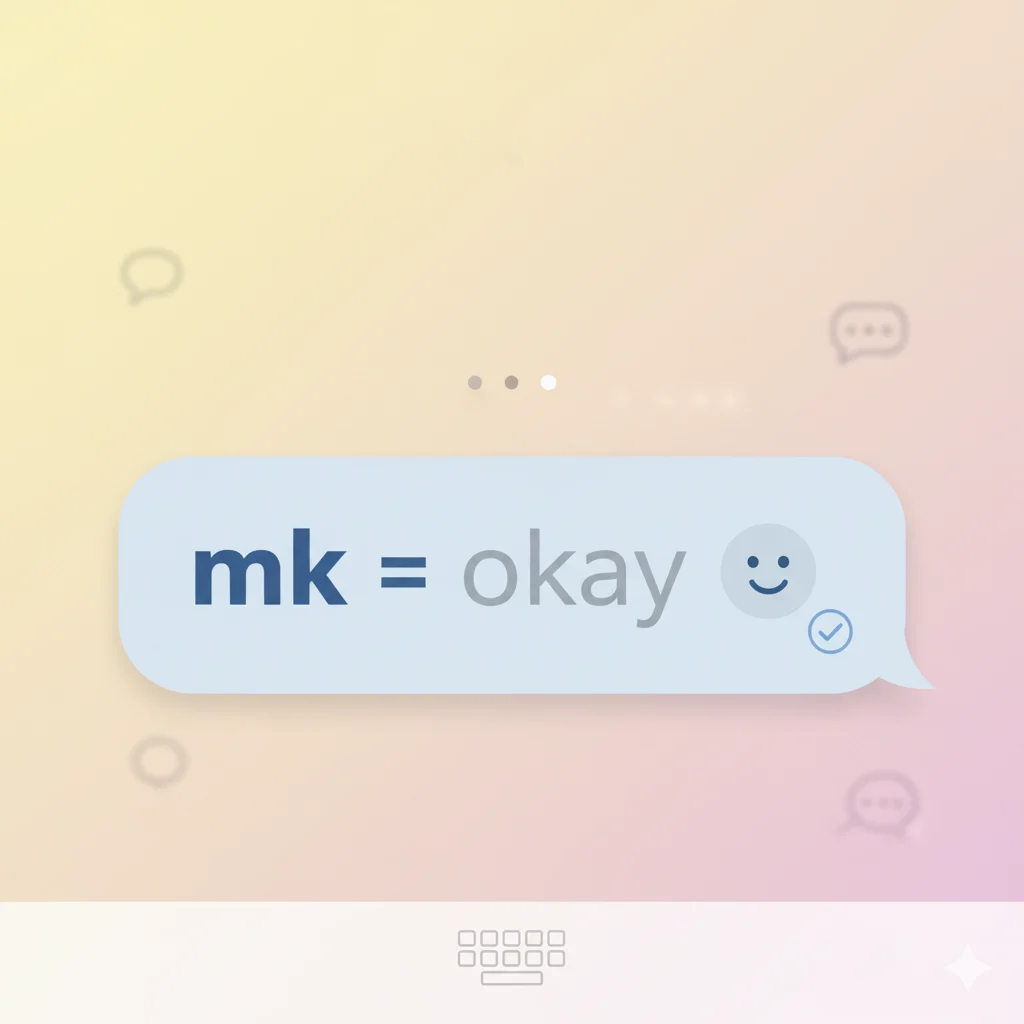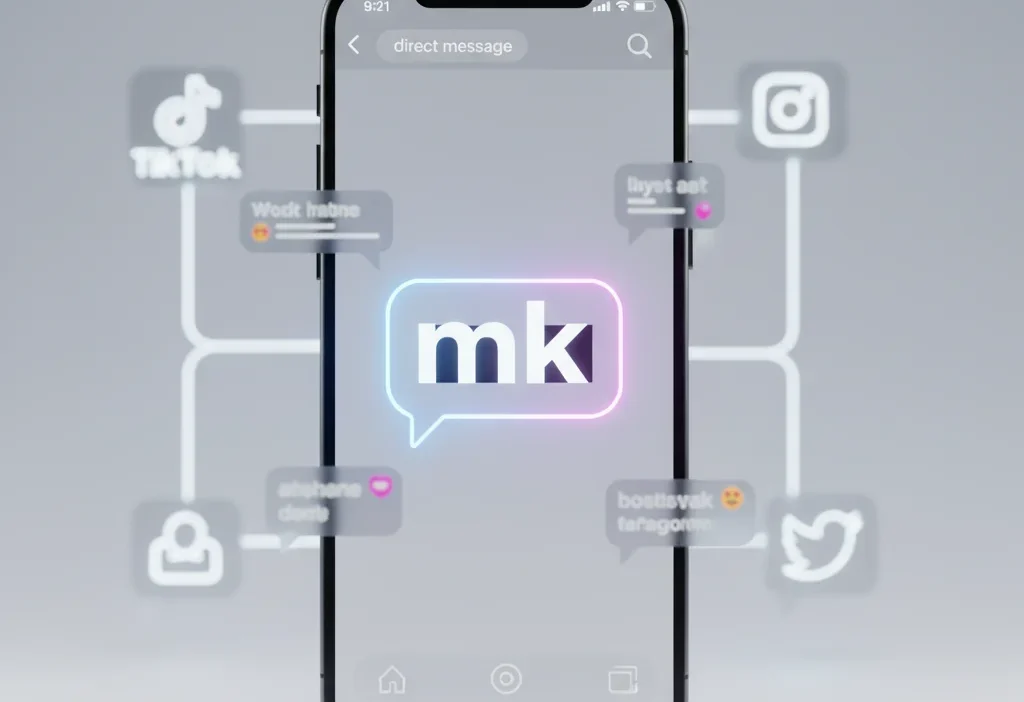MK means “okay.”
It’s a short, casual reply people use in texting to show agreement or acceptance.
Depending on the tone, MK can sound neutral, dry, or slightly annoyed.
Have you ever sent a long message and received a simple “mk” in return — and suddenly started overthinking it? You’re not alone. MK is one of the most common replies in modern messaging, especially among teens and Gen-Z across Snapchat, Instagram, TikTok, WhatsApp, and regular text messages. It’s part of a growing wave of internet shorthand where people prefer short, fast, minimal replies. Yet because MK is so brief, many people misread its tone and wonder whether it means agreement, sarcasm, or annoyance.
Understanding what MK really means — and how its meaning changes with context, punctuation, and mood — can help you avoid confusion in digital communication. This guide breaks down MK’s meaning, tone variations, examples, usage rules, differences from K/Ok, and the small signals that reveal how the other person actually feels.
What Does MK Mean in Text?
In texting, MK simply means “okay.”
It shows agreement, acceptance, or acknowledgment in a short and casual way.
Most people use MK when:

- They want to reply quickly
- They’re busy
- The message doesn’t need a long response
- They’re giving neutral approval
But tone can shift depending on conversation style, mood, and punctuation — which is why MK sometimes feels like a dry reply.
Common Meanings of MK (Explained Simply)
Here’s what MK typically communicates:
| Meaning | Description | When It’s Used |
|---|---|---|
| Okay / Alright | The basic meaning | Everyday conversations |
| Neutral approval | Agreement without excitement | Informational chats |
| Low-effort reply | Short, fast acknowledgment | When someone is busy |
| Slight annoyance | Slightly cold tone | During arguments |
| Dismissive response | Ends the conversation | If someone wants space |
Examples
- “I’ll be there at 7.” → “mk”
- “Send the file today.” → “mk, I will.”
- “I’m disappointed you ignored my call.” → “mk.” (cold/annoyed)
This is why MK is one of the most tone-dependent slang expressions online.
MK on Social Media (TikTok, Snapchat, Instagram)
MK appears a lot in Snapchat streaks, Instagram DMs, TikTok comments, and everyday Gen-Z messaging.

How MK is used on social platforms:
- To shut down an argument (“mk” = I’m done talking)
- To show quick acknowledgment (“mk lol”)
- To give a dry reply when uninterested
- To keep a conversation going without typing much
- To respond to updates in streaks or group chats
On TikTok, MK often appears with Gen-Z slang like fr, idk, mhm, bet, lmk, and the tone shifts quickly depending on mood.
Because MK is extremely short, it’s sometimes associated with dry replies, similar to slang phrases like “ight,” “bet,” or “cool ig.”
MK vs Other “Okay” Replies (Clear Comparison)
| Reply | Tone | Meaning | Warmth Level |
|---|---|---|---|
| MK | Neutral / dry | Okay | ⭐⭐ |
| K | Cold, annoyed | Stop talking / dismissive | ⭐ |
| Ok | Neutral | Simple agreement | ⭐⭐⭐ |
| Okay | Normal, polite | Friendly approval | ⭐⭐⭐⭐ |
| Okayy | Soft, playful | Warm agreement | ⭐⭐⭐⭐⭐ |
| Mkay | Cute, humorous | Slightly playful okay | ⭐⭐⭐⭐ |

MK is not as cold as K, but not as friendly as okayyy or mkay.
When MK Sounds Rude or Cold
MK is not inherently rude — but tone changes everything.
MK may sound rude when:
- There was already tension in the conversation
- You expected an emotional or supportive message
- The other person usually types long replies but suddenly says “mk”
- It has a full stop (“mk.”)
- It’s used to end a discussion
Example that sounds rude:
A: “I’m trying really hard. I hope you understand.”
B: “mk.”
Here the period adds a cold, dismissive tone.
When MK Is Perfectly Normal to Use
MK is completely normal and harmless in casual conversations like:
- When someone says “Be ready at 5.” → “mk”
- When there’s nothing more to say
- When you’re multitasking
- When you’re giving simple agreement
- When you want to reply quickly without ignoring the message
MK is especially common in Snapchat streaks, school chats, gaming chats, and group messages.
Tone Variations of MK (Small Changes, Big Meaning)
| Version | Tone |
|---|---|
| mk | Very neutral |
| mk. | Annoyed, cold, distant |
| mk! | Friendly, upbeat |
| mkk / mkkk | Soft, cute tone |
| Mkay | Playful, warm |
| MK (uppercase) | Stronger, possibly irritated |
These small differences help reveal whether MK means agreement, annoyance, or avoidance.
Examples of MK in Real Conversations
Friendly Chat
A: “Want to play later?”
B: “mk!”
Busy Mood
A: “I’ll call you after class.”
B: “mk”
Slight Annoyance
A: “I forgot again. Sorry.”
B: “mk.”
Playful Teasing
A: “I’m still better at the game.”
B: “mkay sureee 😄”
Dry Reply
A: “I wrote a whole paragraph.”
B: “mk”
(This often feels dismissive)
Why MK Became So Popular
MK exploded in texting culture because:
- It’s fast and effortless
- Fits the Gen-Z trend of minimal replies
- Works across all apps (Snapchat, Insta, TikTok, WhatsApp)
- Avoids over-explaining
- Reduces emotional weight in conversations
- Matches modern slang patterns like idk, fr, mhm, bet, ight
MK is also widely used in TikTok comments where short, dry humor is common.
This is why many people associate MK with dry replies and internet shorthand.
How to Respond to MK (Based on Tone)
If MK is neutral
“mk”
→ “Alright 👍 see you then!”
If MK feels cold
“mk.”
→ “Is everything okay?”
If you want to keep the conversation going
“mk”
→ “Sooo what are you up to right now?”
If you want to end the chat politely
“mk”
→ “Okay, talk later!”
If you want to match their energy
“mkayyy 😄”
MK often pairs well with emojis to soften the tone.
Frequently Asked Questions (FAQs)
1. Does MK mean okay?
Yes, MK almost always means “okay.”
2. Is MK rude?
It depends on tone. Neutral “mk” is fine; “mk.” can feel cold.
3. Is MK the same as K?
No.
- K = annoyed or dismissive
- MK = neutral or lightly dry
4. What does MK mean on Snapchat?
It means okay, got it, or I saw your message.
5. Should I use MK in formal chats?
No — use Okay, Sure, or Noted instead.
Conclusion
MK is a simple, modern texting shorthand that means “okay.” It’s widely used on apps like Snapchat, TikTok, Instagram, and WhatsApp because it’s quick and effortless. While MK is usually neutral, it can sometimes feel dry or slightly annoyed depending on punctuation, mood, and context. Understanding these subtle tone changes helps prevent miscommunication and improves your digital conversations. Whether you choose to use MK or avoid it depends entirely on your texting style — and the level of warmth you want to express.

Oscar Wilde combined wit, beauty, and deep symbolism to reveal the spiritual contrasts of human life. His works often reflect the journey of the soul — from desire and art to truth and redemption. Wilde’s timeless reflections remind readers that beauty and wisdom are paths to understanding the divine within.



